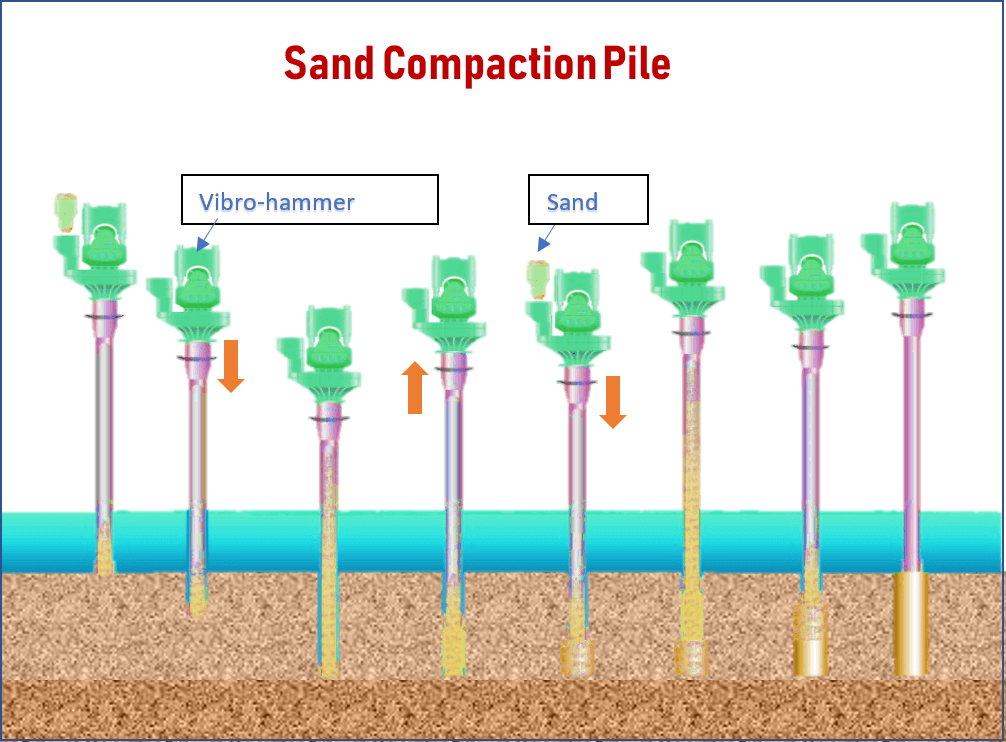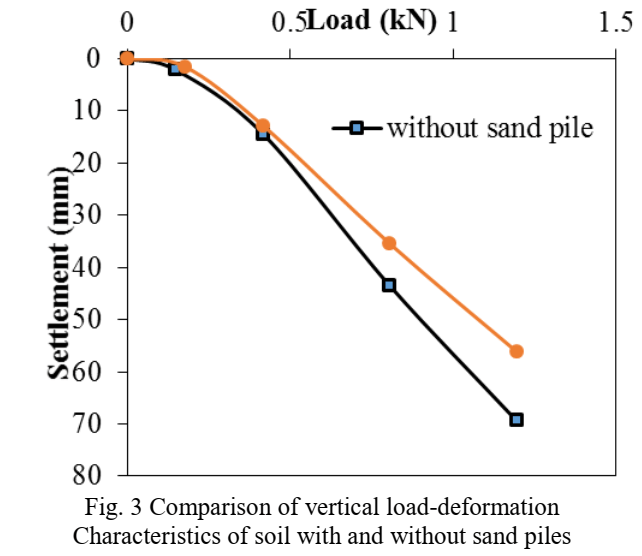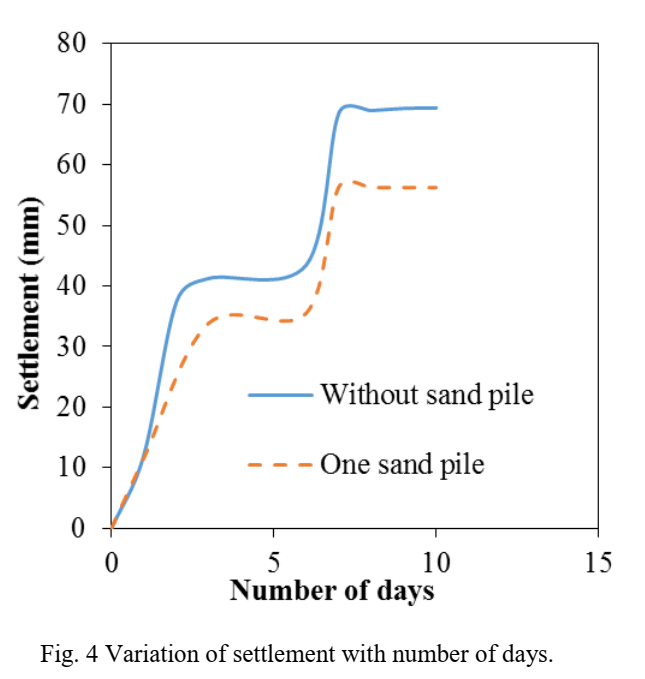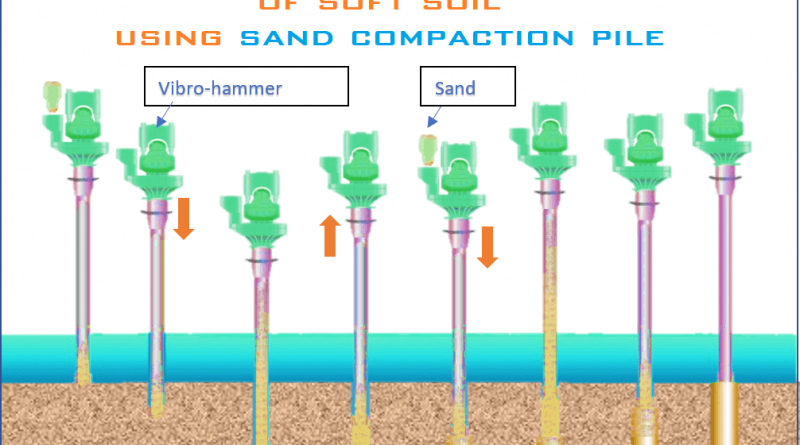Improve bearing capacity of soft soil using sand compaction pile

Soft soil grounds possess low shearing strength and are highly compressible and hence pose a great challenge for geotechnical practitioners, so what is the solution or how to improve bearing capacity of soft soil using sand compaction pile.
The sand compaction pile method is a method of improving soft ground by installing well-compacted sand piles in the ground.
Here we discuss, how laboratory experiments are performed to improve soft clayey silt soil by using a single displacement type granular pile.
The number of tests has been performed on a footing with and without sand compaction piles. Tests results show that the settlement of clayey silt decreases by about 20% after the installation of a single sand pile when compared with that of the un-improved clayey-silt soil layer
Introduction
The soft soil deposits are characterized by their poor strength and compressible behavior. The construction of geotechnical structures becomes challenging when such soil deposits get in-countered at the site.
In such a situation, the geotechnical practitioner usually adopts various ground improvement techniques viz. stabilization using lime, cement, fly ash and sand compaction piles to achieve the desired shear strength to bear the external load from geotechnical structures.
However, the choice of particular ground improvement technique is dependent upon the subsoil strata present at the site.
Some of the ground improvement techniques are primarily for clay and some are specifically for sand. Considering the wide variability of the subsoil strata, it is always advisable to adopt such a technique which can be efficient in non-homogeneous subsoil conditions.
Sand Compaction Pile method is referred to as a method of ground improvement technique in which dense sand columns are casted by forcibly injecting sand into in-situ loose subsoil profile.
Benefits of Sand compaction Pile
- Sand compaction pile is cheaper than another ground improvement solution because sand is available at a low cost.
- Installation of sand compaction pile is much faster.
- Its installation is safe because after boring there is less chance of collapse of the bore due to self-casing of sand pile.
Sand compaction piles were practically applied as densification method in 1957.
Sand compaction piles are installed by first driving a cylindrical casing into the ground up to desired depth thereby sands are poured and compacted by using a vibratory hammer. The casing is then withdrawn to 2 m to 3 m and then re-driven to 1 m to 2 m. After continuous driving and lowering, the casing is withdrawn which results in fully compacted sand piles with a larger diameter than the casing diameter.
This is done to improve the load-bearing capacity, to reduce settlements and to increase the degree of consolidation of the subsoil. The load-carrying capacity depends upon the lateral confining pressure from surrounding soils.
Their application includes support to rail and road embankments, raft foundation and other low-rise structures.
Sand compaction piles have been widely used in Japan and Singapore for the rapid stabilisation of soil clay sea bed soil in land reclamation work.
Sand compaction piles can be used for all soil types and therefore has been recognised as a widely used method for improving the soft ground. Various research work has been carried out on the improvement of soil properties due to the installation of sand piles.
Improve the Bearing capacity of soft soil using sand compaction pile by following test method…
2. Materials and Methodology
The present study uses soft soil to fulfilling the objectives of the study. The sandy soil chosen in the present study is also readily available and used for geotechnical construction purposes.
The geotechnical tests are carried out at the geotechnical laboratory of the National Institute of Technology.

2.1 Testing Tank
A steel test tank of size 36 cm x 36 cm x 60 cm was used to carry out the load tests. The tank is of rectangular cross-section provided with handles so that it can be easily lifted and placed. It is transparent on two adjacent sides, made of tough glass so that arrangements can be checked from outside. The other two adjacent sides are made of steel.
2.2Model Footing
The model footing used in the experimental investigation was made up of steel circular plate with a diameter of 15 cm and 9 cm thickness.
2.3 Test Material
2.3.1 Clayey-silt Soil
All the tests have been conducted in a tank of size 36 cmx36 cmx60 cm. The soil is mixed with water equal to its liquid limit. The thoroughly mixed soil is placed in the test tank to a depth of 25 cm in layers, each layer being compacted to remove the presence of air voids. The soil bed is allowed for consolidation. The physical and engineering properties of the clayey-silt type of soil are evaluated experimentally and the values are reported in Table 1.

2.3.2 Sandy Soil
A steel pipe having an external diameter of 1.5 cm has been used to prepare the sand column. The sand used for the construction of the sand piles has been collected from the local market and the properties of the sandy soil are reported in Table 1. The sand columns are installed in the clayey-silt soil bed by driving the steel pipe statically. A steel rod with a closed circular base was inserted into the pile, to prevent the entry of the sand into the pipe during driving. The length of the sand column was 25 cm which is 1.6
times the diameter of the footing. Special care has been taken to maintain the verticality of the sandpile during installation.
2.4 Test Methodology
The load test is carried out in a rectangular tank of size 36 cm x 36 cmx 60 cm. Clayey-silt soil bed of 25 cm is prepared in layers and is then rested for consolidation. A sand blanket of 5 cm is placed over the soil bed. A circular model footing of 9 cm thickness and a diameter of 15 cm is placed over the sand bed and vertical load test is conducted by applying load in increment in a sequential manner till 120 kg i.e. 1.2 kN with the help of rectangular steel plates and each increment of the load had been allowed until very little change(less than 0.002 mm/min) in the settlement is observed. The detail of the arrangement is
shown in Fig. 1.

The settlement of the footing is measured with a dial gauge of least count 0.01mm and recorded. The value of the settlement is observed for 10 days. The verticality of the sandpile is ensured by a steel casing. The pipe is driven in the clayey-silt soil bed and sand is poured into the pipe using a funnel. After construction of the sandpile, a 5 cm layer of the sand blanket is placed over the soil bed. Now, the circular
footing is placed over it and loading arrangements are done again to measure the time required for the fixed value of the settlement. The above procedure of load test is done to study the load settlement characteristics of the composite foundation system. The load setup arrangement for the clayey-silt layer improved with sand pile is shown in Fig. 2.

3. Results and Discussions
Firstly, vertical loads are applied on footing without sand piles and then the load-deformation response of circular footing is obtained. Thereafter, a sand pile of length 25 cm and diameter 1.5 cm is constructed at the center of the soil model and then footing is laid over it.
Further, load-deformation characteristics of the soil improved with sand compaction pile are obtained. Herein, loadings are applied in an incremental manner and the readings are noted using dial gauge fixed at the top of the steel plates.

Figure 4 illustrates the change in the settlement level with an increase in the number of days for both conditions of the tests i.e. footing without sand pile and footing with a single sand pile.
It can be seen that footing with sand pile is undergoing lesser settlement as compared to footing without sand pile. This may be due to the sharing of the load by the sand compacted pile.
Figure 3 illustrates the load settlement response of the footing in soft soil with and without sand compaction pile. It can be seen that there is a marked decrease in the level of settlement in footing improved with sand compaction pile when compared with footing without sand compaction pile.
At the end of the tests, the maximum settlement obtained for footing with and without sand compaction piles is 56.18 mm and 69.42 mm respectively.

At 1.2 kN of vertical load, the settlement observed in footing with sand piles is observed to be 20% less than the settlement observed in the footing without sand piles.
Hence, it can be stated that sand compaction pile can be used as an alternate method to improve the soft soil.
4. Conclusions
There is a conclusion for testing of Improve Bearing capacity of soft soil using sand compaction pile
Following conclusions can be made after successful completion of the tests on footing resting on clayey-silt with and without sandpile:
• The load-deformation characteristics of clayey silt with and without sand compaction pile is
found to be non-linear.
• The maximum settlements of 56.18 mm and 69.42 mm are obtained for footing with and
without a sand compaction pile for a vertical load of 1.2 kN.
• It is also observed that footing rested on clayey silt with a sand compaction pile undergoes 20%
less settlement than the footing rested on clayey silt without sand piles.
• Hence, it can be stated that sand compaction pile can be used as an alternate method to improve
the clayey-silty soil.
Disclaimer- I am an amazon affiliate marketer. All given links in this post are for promoting amazon. Please ensure to buy something from Amazon
Another Article for You…
- Easy Bar Bending Theory with example
- What is Geosynthetics?





best website for all civil engineers
https://civilengineersgyan.blogspot.com/search/label/interview%20ouestion